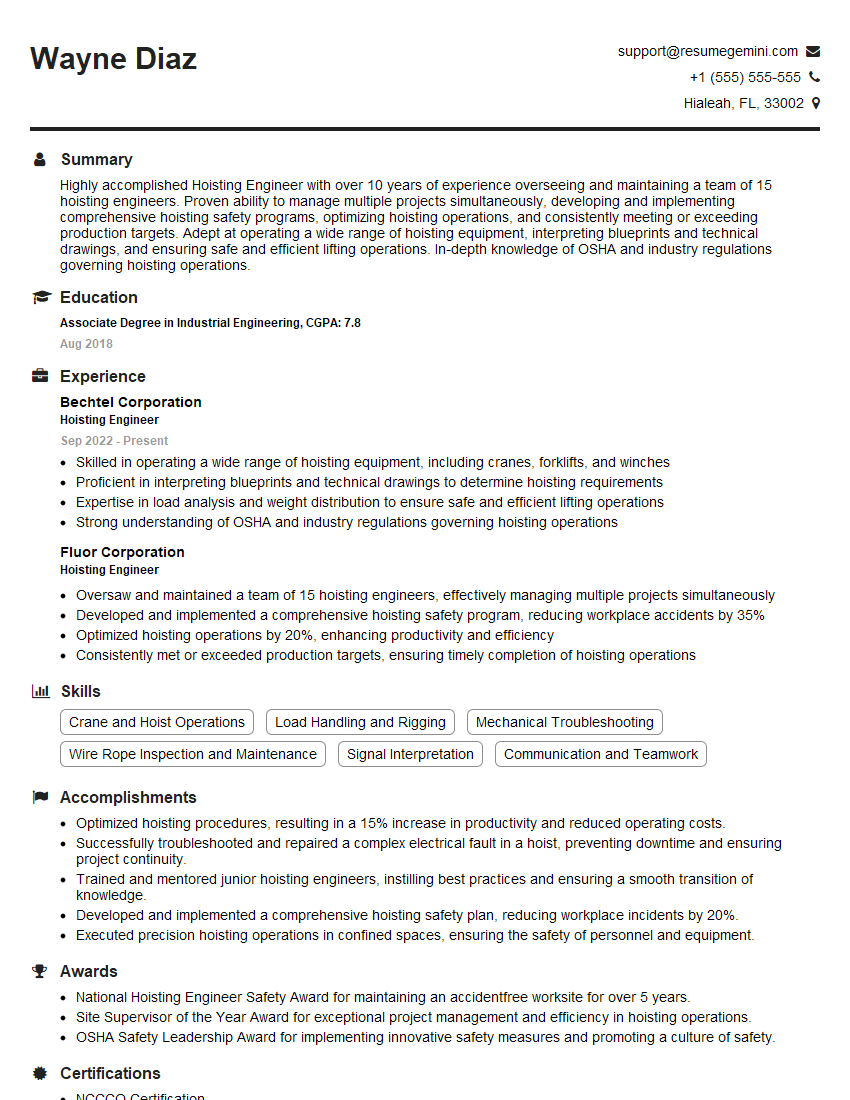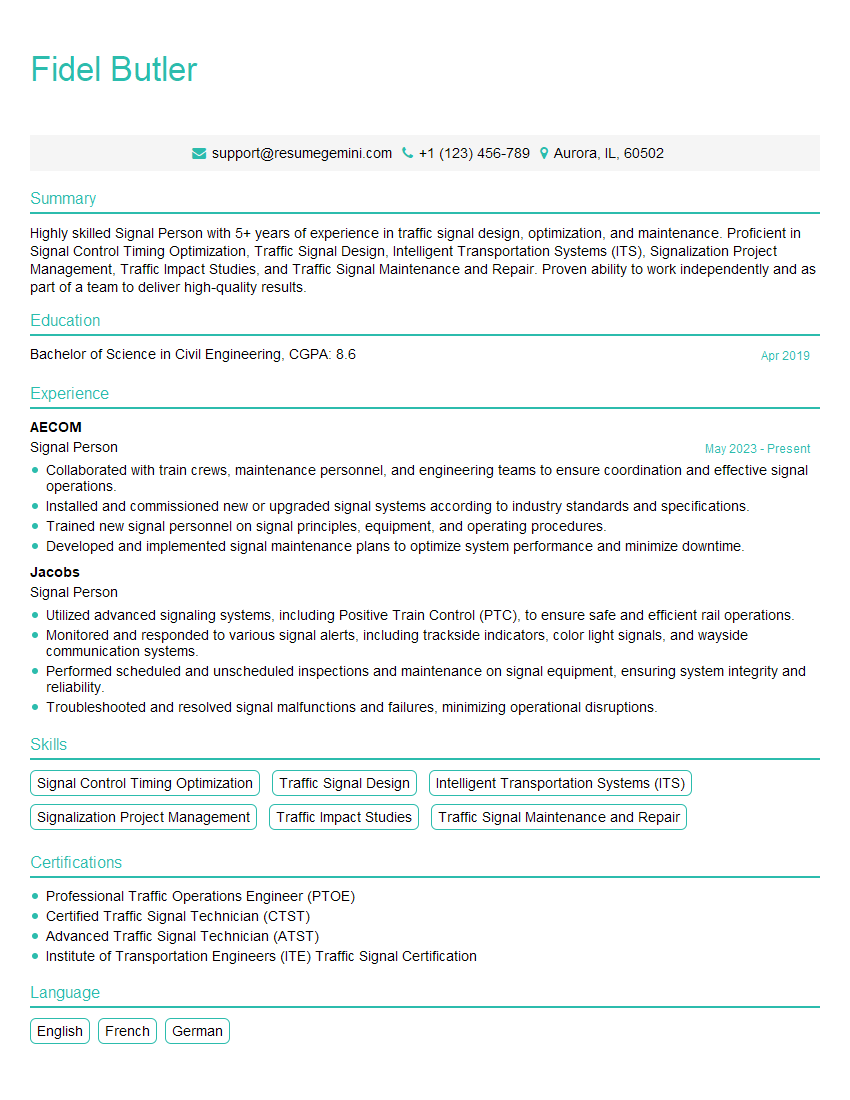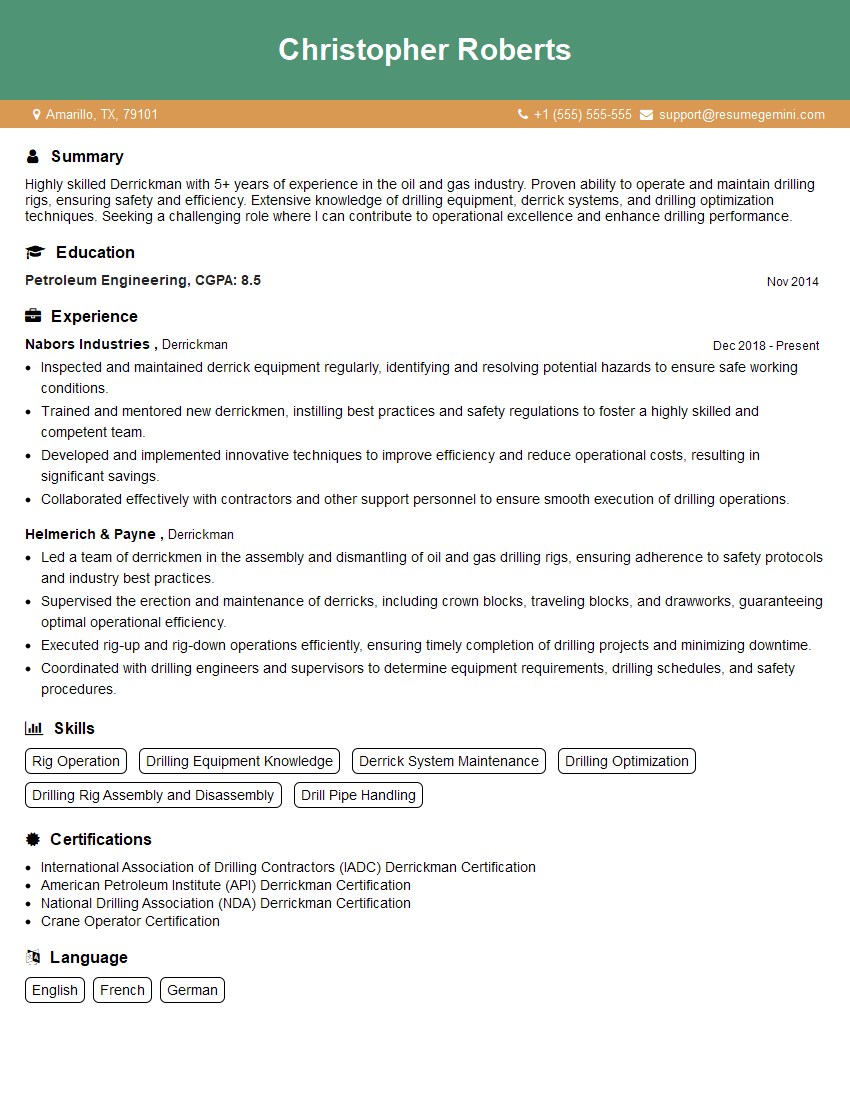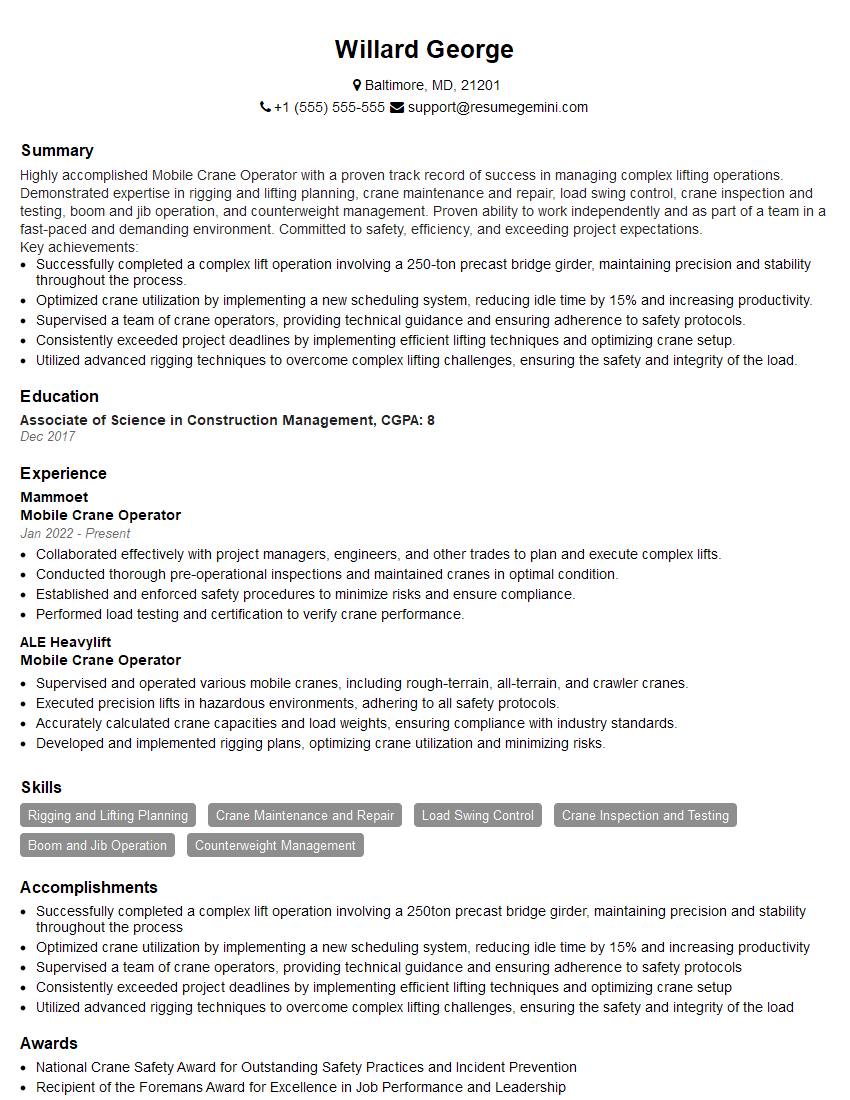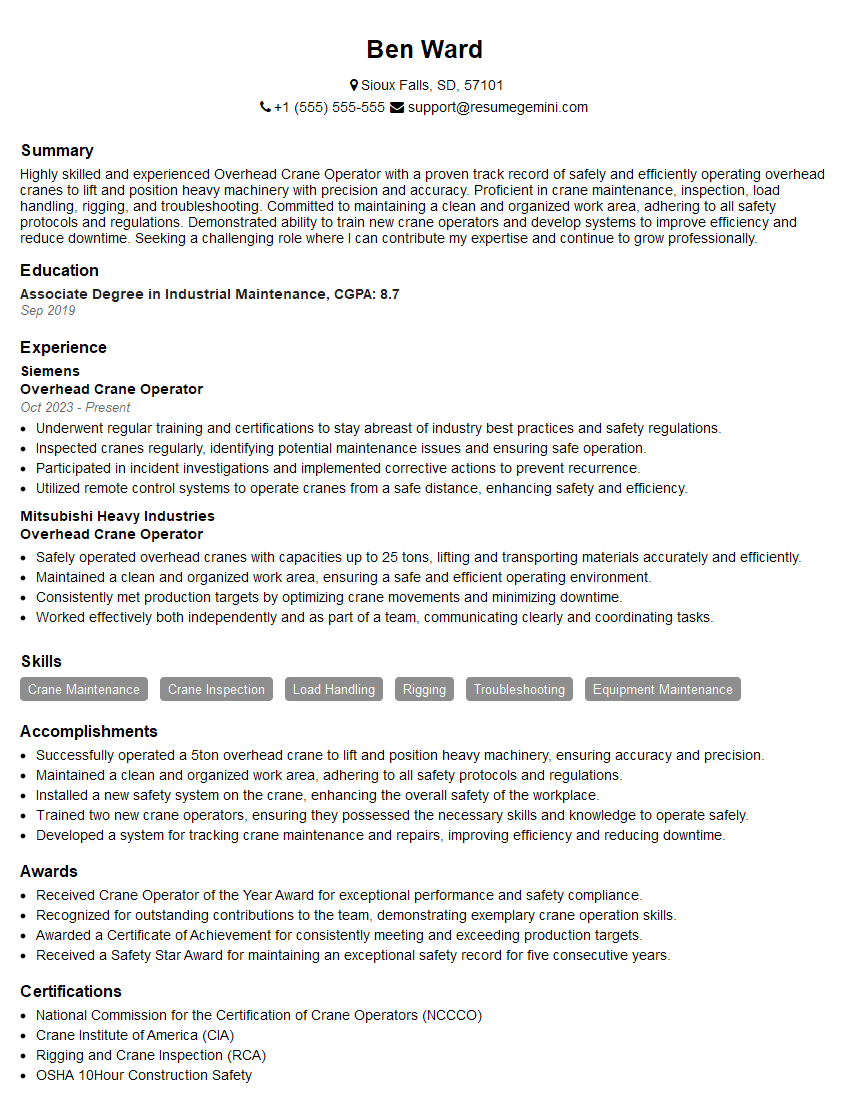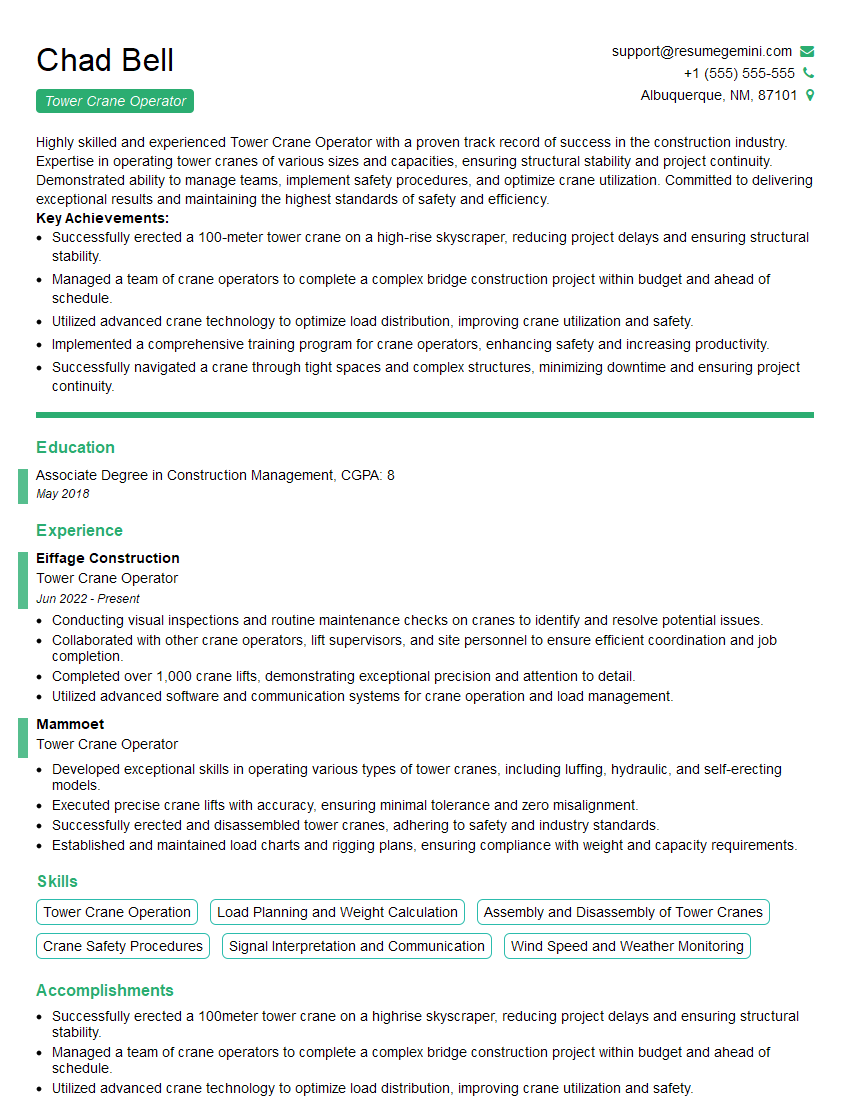Preparation is the key to success in any interview. In this post, we’ll explore crucial Lifting Operations interview questions and equip you with strategies to craft impactful answers. Whether you’re a beginner or a pro, these tips will elevate your preparation.
Questions Asked in Lifting Operations Interview
Q 1. Explain the different types of lifting equipment.
Lifting equipment encompasses a wide range of machinery used to hoist, move, and position heavy objects. The specific type of equipment chosen depends heavily on the load’s weight, size, and the environment. Here are some key categories:
- Cranes: These are the workhorses of heavy lifting, ranging from small mobile cranes to massive tower cranes used on construction sites. They employ various lifting mechanisms like hooks, magnets, or specialized grabs.
- Hoists: These are powered or manual devices designed for vertical lifting, commonly found in factories, warehouses, and workshops. Types include chain hoists, wire rope hoists, and electric hoists.
- Jacks: These are used for lifting relatively lighter loads, often in situations where a crane isn’t feasible or necessary. Hydraulic jacks are particularly common.
- Forklifts: While not strictly lifting equipment in the same sense as cranes, they’re crucial for moving palletized loads and are vital in many industries.
- Lifting Beams and Slings: These are essential accessories that distribute the load from the lifting point to the object being lifted, ensuring stability and preventing damage.
- Vacuum Lifters: These utilize suction to lift flat and smooth materials, perfect for handling glass, stone, or sheet metal.
Choosing the right equipment for the job is paramount to safety and efficiency. For instance, attempting to lift a heavy object with a jack designed for much lighter loads is extremely dangerous.
Q 2. Describe your experience with load charts and safe working loads.
Load charts and safe working loads (SWLs) are fundamental to safe lifting operations. The load chart provides critical information about the equipment’s capacity under various configurations and conditions. The SWL is the maximum load the equipment can safely lift without risk of failure. My experience involves extensive use of load charts for various types of cranes, hoists, and slings. I meticulously cross-reference the load chart with the actual weight of the load, factoring in any potential additional stresses such as wind or angle of lift. I never exceed the SWL under any circumstances. For example, I’ve had instances where a seemingly simple lift required recalculation due to wind conditions – the actual SWL was reduced by 25% due to the strong gusts, necessitating a change in equipment.
I’ve also been involved in scenarios where equipment manufacturers provide specific guidelines that take precedence over general load charts. I’m adept at understanding how these nuances impact the SWL and I always prioritize safety.
Q 3. How do you ensure the safe assembly and disassembly of lifting equipment?
Safe assembly and disassembly of lifting equipment is a crucial aspect of preventing accidents. This involves a thorough understanding of the equipment’s manual and adhering to manufacturer’s guidelines precisely. Before commencing any assembly, I meticulously inspect all components for damage or wear. All parts are carefully aligned and secured, using the correct fasteners and procedures. During assembly, regular checks are performed to ensure stability and correct alignment. The entire process is overseen by a competent supervisor, with appropriate safety precautions like fall protection or spotters in place. For example, when rigging a crane, I conduct a thorough inspection of all the components – hooks, shackles, slings – and ensure that all connections are properly secured with the correct number of safety latches or pins.
Disassembly follows a similar process. Loads are carefully released in a controlled manner, and equipment is de-rigged systematically and safely, preventing accidental dropping of components.
Q 4. What are the common hazards associated with lifting operations?
Lifting operations present numerous hazards, and understanding these is vital for risk mitigation. Common hazards include:
- Equipment failure: This can result from overloading, improper maintenance, or defects in the equipment itself. This could lead to dropped loads or equipment collapse.
- Struck-by hazards: Workers can be struck by falling objects, swinging loads, or collapsing equipment.
- Caught-in/between hazards: Workers could be caught between moving parts of the equipment or crushed by the load itself.
- Electrocution: Contact with energized equipment or power lines during lifting poses a significant risk.
- Slips, trips, and falls: Unstable ground conditions or cluttered work areas can contribute to accidents.
- Environmental hazards: Extreme weather conditions like wind or rain can significantly affect the safety of lifting operations.
These hazards highlight the importance of thorough risk assessments, comprehensive training, and strict adherence to safety regulations.
Q 5. Describe your experience with pre-lift planning and risk assessments.
Pre-lift planning and risk assessments are critical for safe and efficient lifting operations. My experience involves developing detailed plans that include:
- Defining the scope of work: This includes identifying the load’s weight, dimensions, and center of gravity.
- Selecting appropriate equipment: Choosing equipment with sufficient capacity for the load and suitable for the environment.
- Developing a lifting plan: This outlines the sequence of operations, including rigging, lifting, and positioning of the load.
- Conducting a risk assessment: Identifying potential hazards and implementing control measures to mitigate the risks.
- Implementing communication protocols: Establishing clear communication channels between the crane operator, riggers, and other personnel involved.
One example involved lifting a large transformer. The plan included weather contingency measures, the use of specialized slings, and a detailed communication plan to coordinate the lift safely and efficiently. The risk assessment highlighted potential hazards such as high voltage and the need for additional safety measures, ultimately leading to a successful and safe operation.
Q 6. Explain the importance of regular inspections of lifting equipment.
Regular inspections of lifting equipment are crucial for preventing accidents and ensuring operational safety. These inspections identify potential defects or wear and tear before they lead to catastrophic failure. The frequency of inspections depends on the type of equipment, usage intensity, and local regulations, but generally includes daily, weekly, and periodic thorough examinations. I’ve personally conducted and supervised countless inspections, using detailed checklists to ensure nothing is overlooked. These checklists cover everything from visual inspections of cables and hooks for wear and tear, to functional checks of brakes and other mechanical systems. We often use documentation software to record the findings from each inspection, facilitating improved maintenance scheduling.
A timely inspection can prevent a catastrophic failure. For example, a daily inspection might reveal a small crack in a sling that, if left unattended, might have led to a complete sling failure during a lift.
Q 7. What are the legal requirements for lifting operations in your region?
(Note: This answer will vary depending on the specific region. Replace the following with the relevant regulations for your area.)
In my region, lifting operations are governed by a comprehensive set of regulations, including but not limited to: [Insert specific regulations and acts relevant to the area. For example: Occupational Safety and Health Administration (OSHA) regulations in the USA, or equivalent regulations in other countries]. These regulations cover various aspects, including equipment certification, operator training and licensing, pre-lift planning, risk assessments, maintenance and inspection procedures, and emergency response planning. Non-compliance with these regulations can result in significant penalties, including fines and even criminal charges. I am well-versed in these regulations and ensure that all my work fully complies with them.
Q 8. How do you communicate effectively with a crane operator or rigger?
Effective communication with crane operators and riggers is paramount for safe lifting operations. It’s about clear, concise instructions and a shared understanding of the task. I always employ a system of pre-lift meetings, where we review the lifting plan, discuss potential hazards, and assign roles and responsibilities. During the lift, I use hand signals according to established standards (e.g., ASME B30.5), supplemented by clear verbal confirmation. For instance, before initiating a lift, I’d confirm the load weight, sling configuration, and the intended landing spot with the operator. Post-lift, I ensure a debriefing to discuss what went well, and what could be improved for future operations. Open communication, actively listening to the operator’s feedback, and valuing their expertise are crucial for preventing accidents.
Q 9. Describe your experience with different types of slings and their applications.
My experience encompasses a wide range of slings, each suited for specific applications. I’m proficient with:
- Wire rope slings: These are robust and durable, ideal for heavy-duty lifting and high-temperature environments. However, they require careful inspection for wear and damage. I’ve used them extensively in structural steel erection projects.
- Synthetic fiber slings (e.g., polyester, nylon): Lighter than wire rope, these slings offer excellent flexibility and shock absorption. They’re suitable for lifting delicate or oddly shaped loads. I’ve used them frequently in the transportation and assembly of large machinery.
- Chain slings: Strong and resistant to abrasion, chain slings are well-suited for lifting heavy, bulky materials in harsh conditions. However, they require regular lubrication and inspection for wear. I’ve utilized these in demolition projects.
- Mesh slings: Designed for handling awkward or oddly shaped loads, they conform to the load’s shape, distributing the weight evenly. I’ve found them particularly useful in lifting large concrete components.
Selecting the appropriate sling depends on factors like load weight, shape, material, and environmental conditions. A thorough understanding of sling capacities, safe working loads, and potential hazards is essential.
Q 10. How do you handle unexpected situations during a lift?
Unexpected situations during a lift require immediate, calm, and decisive action. My approach involves:
- Immediate Stop: The first priority is to halt the lift immediately and assess the situation.
- Identify the Problem: Determine the cause of the unexpected event. Is it a mechanical failure, a change in wind conditions, or a problem with the load?
- Evaluate Risks: Assess the potential hazards to personnel and equipment.
- Implement Corrective Actions: Develop and implement a safe solution. This might involve reevaluating the lifting plan, adjusting the sling configuration, or calling for additional resources.
- Communication: Maintain clear communication with the crane operator, riggers, and other personnel involved.
- Documentation: Thoroughly document the incident, including the cause, actions taken, and lessons learned.
For example, if a sling breaks during a lift, my immediate response is to signal the operator to stop, secure the load safely (if possible), and then initiate an investigation into the cause of the sling failure. This might include a thorough examination of the sling and a review of the pre-lift inspection procedures.
Q 11. Explain the concept of load stability and its importance.
Load stability refers to the ability of a suspended load to remain balanced and controlled during a lift. It’s crucial for preventing accidents and damage. Factors affecting load stability include:
- Load Center of Gravity: The load’s center of gravity must be properly positioned to prevent swinging or tilting.
- Load Securement: Proper slinging and load securing techniques are crucial for maintaining stability.
- Wind Conditions: High winds can destabilize even well-secured loads.
- Crane Operation: Smooth and controlled crane movements are essential for load stability.
Maintaining load stability is paramount for safety. An unstable load can swing uncontrollably, potentially causing collisions, damage to property, and serious injury. I always ensure that the load is properly secured, the center of gravity is identified, and the crane operator understands the load’s characteristics before initiating a lift.
Q 12. What are the different types of crane movements and their risks?
Crane movements, if not executed properly, present significant risks. Different movements include:
- Hoisting/Lowering: Risks include load instability, cable breakage, and collisions.
- Swinging: Risks include load collision with obstacles or personnel.
- Slewing (rotating): Risks include collisions with surrounding structures or equipment.
- Traveling (moving the crane): Risks include tipping or structural failure.
- Jibbing (adjusting the boom length): Risks include load instability and boom collapse.
Mitigation involves using proper techniques, ensuring the load is appropriately secured, and carefully controlling the crane’s movements. Pre-lift planning and risk assessments are crucial in identifying and managing these risks.
Q 13. How do you identify and mitigate potential hazards related to wind speed?
Wind speed is a significant hazard in lifting operations. High winds can destabilize loads, causing them to swing violently or even overturn. My approach to managing wind-related hazards is threefold:
- Wind Speed Monitoring: I always check the current wind speed and direction before, during, and after a lift, using anemometers or relying on weather forecasts. Many sites will have restrictions on lifting operations once wind speeds exceed certain levels.
- Wind Speed Limits: I adhere strictly to established wind speed limits for lifting operations, which are often specified in the lifting plan or by regulatory authorities. This is critical for the safety of personnel and the stability of the lift.
- Mitigation Strategies: If wind conditions are approaching or exceeding these limits, I might implement strategies like delaying the lift, using additional rigging equipment to stabilize the load, or modifying the lift plan altogether. In extreme conditions, suspending operations is often the safest course of action.
For example, if the wind is gusting above the allowable limit for a particular lift, I will communicate this to the supervisor and the crane operator, and propose a delay until the wind subsides. Safety always comes first.
Q 14. What is your experience with different types of lifting plans?
My experience covers several types of lifting plans, each tailored to the specific requirements of the lift:
- Simple Lifting Plans: These are used for straightforward lifts with minimal complexities, often for routine tasks.
- Complex Lifting Plans: These are necessary for challenging lifts involving multiple cranes, specialized equipment, or complex rigging arrangements.
- Critical Lift Plans: These are employed for lifts deemed high-risk due to load size, weight, or environmental factors. They often include detailed risk assessments, emergency procedures, and multiple layers of review and approval.
- Method Statements: Detail the entire lifting procedure, highlighting the equipment to be used, and the personnel involved, and describing any special considerations for the lift.
Each plan needs to clearly define the load details (weight, dimensions, center of gravity), equipment specifications, rigging procedures, risk assessment and mitigation measures, and emergency procedures. I’m proficient in creating and reviewing these plans, ensuring they comply with relevant safety standards and regulations.
Q 15. Describe your understanding of the principles of leverage and mechanical advantage.
Leverage and mechanical advantage are fundamental principles in lifting operations. Leverage is the use of a rigid bar (lever) pivoted on a fulcrum to lift or move a load. Mechanical advantage is the ratio of the output force (the load lifted) to the input force (the effort applied). A higher mechanical advantage means you can lift heavier loads with less effort.
Imagine a simple seesaw. The fulcrum is the pivot point in the middle. If you place a heavy object close to the fulcrum, you need to apply more force farther away to lift it. This demonstrates leverage. The ratio of the weight of the object to the force you exert represents the mechanical advantage. A longer lever arm increases the mechanical advantage, making it easier to lift the load.
In lifting operations, this principle is applied in various ways. For example, a crane’s boom acts as a lever, and its design optimizes mechanical advantage to lift heavy loads. Similarly, pulley systems use multiple pulleys to create a higher mechanical advantage, allowing workers to lift objects much heavier than they could manually.
Career Expert Tips:
- Ace those interviews! Prepare effectively by reviewing the Top 50 Most Common Interview Questions on ResumeGemini.
- Navigate your job search with confidence! Explore a wide range of Career Tips on ResumeGemini. Learn about common challenges and recommendations to overcome them.
- Craft the perfect resume! Master the Art of Resume Writing with ResumeGemini’s guide. Showcase your unique qualifications and achievements effectively.
- Don’t miss out on holiday savings! Build your dream resume with ResumeGemini’s ATS optimized templates.
Q 16. How do you ensure the safety of personnel near lifting operations?
Ensuring personnel safety near lifting operations requires a multi-layered approach. This begins with establishing a clearly defined exclusion zone around the lifting area. Only authorized personnel wearing appropriate PPE (Personal Protective Equipment) – including hard hats, safety glasses, and high-visibility clothing – are permitted within this zone. Signage should clearly demarcate the boundaries and any specific safety instructions.
Before initiating the lift, a thorough risk assessment is crucial. This identifies potential hazards, such as overhead obstructions, unstable ground, or nearby power lines. A competent person must supervise the operation, ensuring all personnel are aware of the planned lift procedure and potential risks. Regular communication between the crane operator and the ground crew is vital, using hand signals or a designated communication system. Emergency procedures, including designated escape routes and emergency shutdown mechanisms, must be clearly communicated and practiced. Finally, regular maintenance and inspection of the lifting equipment are essential to minimize the risk of equipment failure.
Q 17. Describe your experience with emergency procedures during lifting operations.
I have extensive experience handling emergency situations during lifting operations. One instance involved a sudden power failure during a critical lift of a large transformer. The crane was equipped with an emergency lowering system, which I immediately activated following established procedures. This allowed for the controlled lowering of the transformer, preventing any damage or injury. Another instance involved a sling failure. We had pre-planned emergency procedures which were implemented promptly. The load was quickly secured and the damaged sling was immediately replaced before resuming operations. These experiences highlighted the importance of thorough planning, regular equipment inspections, and having well-rehearsed emergency protocols.
In all instances, the safety of personnel was the paramount concern. Clear communication, swift action, and adherence to established procedures prevented any serious accidents or injuries.
Q 18. What is your experience with different types of lifting accessories?
My experience encompasses a wide range of lifting accessories, including various types of slings (wire rope, synthetic fiber, chain), shackles, hooks, and spreader beams. I am familiar with their respective load limits, proper inspection techniques, and the importance of selecting the appropriate accessory for the specific load and lifting conditions. For instance, I’ve used wire rope slings for lifting heavy steel components due to their high tensile strength, while synthetic fiber slings are preferred for delicate or easily scratched materials because they offer better protection.
I understand the significance of regular inspection of these accessories for wear and tear, damage, or any signs of deformation. Any accessory showing even minor damage is immediately removed from service and replaced to ensure the safety of the operation. Selecting the appropriate lifting accessory is crucial and depends on factors such as the load’s weight, shape, and material.
Q 19. Explain your understanding of different types of crane failures and their causes.
Crane failures can stem from various causes, broadly categorized as structural, mechanical, or electrical failures. Structural failures can involve issues with the boom, jib, or the main structure of the crane due to fatigue, corrosion, or overloading. Mechanical failures can arise from problems with the hoisting mechanism, brakes, or other moving parts. This might include worn components, improper lubrication, or lack of maintenance. Electrical failures can include short circuits, faulty wiring, or problems with the control system.
For example, a poorly maintained brake system can lead to a runaway load, resulting in a serious accident. Corrosion of structural components can weaken the crane’s structural integrity, leading to catastrophic failure. Regular inspections, preventative maintenance, and adherence to manufacturer’s recommendations are crucial for preventing these failures.
Q 20. How do you handle lifting operations in confined spaces?
Lifting operations in confined spaces demand meticulous planning and execution. The confined nature of the space necessitates careful consideration of several factors. Firstly, the size and maneuverability of the crane must be suitable for the restricted space. Secondly, the load’s dimensions and weight must be carefully assessed to ensure it can be moved safely without causing damage to the surroundings or the structure. Thirdly, the accessibility of the lifting points and the potential obstacles within the confined space must be carefully considered. The use of smaller, more maneuverable cranes or specialized lifting equipment may be necessary. Furthermore, the risk of personnel injury is amplified in confined spaces, demanding stringent safety precautions, including the use of appropriate PPE, clearly defined communication protocols, and thorough risk assessment. A confined space entry permit may also be required depending on the specifics of the space.
Q 21. Describe your experience with the use of lifting equipment in various weather conditions.
Experience with lifting equipment in various weather conditions is critical. Wind is a major concern. High winds can affect the stability of the crane and make it difficult to control the load. Rain can reduce visibility and create slippery conditions, making the operation more dangerous. Extreme temperatures can affect the performance of the crane’s components, such as the hydraulic system or the brakes. In snowy or icy conditions, there’s an increased risk of slips, trips, and falls, along with potential equipment malfunction due to freezing temperatures.
To mitigate these risks, we follow established procedures that include assessing weather conditions before commencing any lifting operation. If conditions are unsuitable (e.g., high wind speeds, heavy rain, snow), the operation is postponed until conditions improve. In some instances, specialized equipment or techniques might be necessary to operate safely in challenging conditions. In windy conditions, for example, we might need to reduce the load weight or use additional counterweights to ensure stability.
Q 22. What is your experience with using personal protective equipment (PPE) during lifting operations?
Personal Protective Equipment (PPE) is paramount in lifting operations. My experience encompasses consistent and meticulous use of appropriate PPE, tailored to the specific task and environment. This includes, but isn’t limited to, safety helmets, high-visibility clothing, safety footwear with steel toe caps and puncture resistance, and appropriate gloves depending on the load (e.g., cut-resistant gloves for sharp materials). For overhead lifting, I always utilize a harness and appropriate fall protection equipment. I regularly inspect my PPE before each operation, ensuring it’s in good working condition and fits correctly. For instance, I once identified a small tear in my glove before lifting a heavy steel beam – preventing a potential hand injury.
Furthermore, I am acutely aware of the importance of choosing the right PPE for the hazards presented. Working with chemicals might necessitate specialized respirators, while working at heights mandates specific harnesses and fall arrest systems. My consistent and proactive approach to PPE ensures a safe and secure work environment for myself and my colleagues.
Q 23. How do you comply with all relevant safety regulations and standards?
Compliance with safety regulations and standards is non-negotiable. I meticulously adhere to OSHA (Occupational Safety and Health Administration) guidelines, as well as relevant industry-specific standards like ASME (American Society of Mechanical Engineers) for cranes and hoists. I’m familiar with local regulations and company-specific safety procedures. My approach involves proactive risk assessments before any lift, ensuring all personnel are briefed on the hazards and control measures. This includes understanding load capacity limitations, safe working loads (SWL) for equipment, and appropriate lifting techniques. For example, before a particularly complex lift involving a very heavy component, I conducted a thorough risk assessment and developed a detailed lifting plan, including emergency procedures, that was reviewed and approved by my supervisor and safety officer.
Regularly scheduled equipment inspections and maintenance are also vital components of my approach. I ensure all lifting equipment, including cranes, slings, and shackles, are regularly inspected and certified, with records meticulously maintained. This proactive approach ensures that the equipment is safe and functioning correctly, significantly reducing the risks associated with lifting operations. Any deviations or non-compliances are immediately reported and addressed.
Q 24. Explain your experience with creating and implementing lifting plans.
Creating and implementing lifting plans is a cornerstone of my expertise. I’ve developed numerous lifting plans across diverse projects, from small-scale lifts in confined spaces to large-scale industrial lifts involving heavy machinery. My approach involves a systematic process. First, I conduct a thorough site survey, identifying potential hazards and constraints, such as structural limitations or overhead obstructions. I then determine the weight, center of gravity, and dimensions of the load. Next, I select appropriate lifting equipment with sufficient capacity and considering the load’s characteristics and the environment. For example, a sharp load might necessitate the use of soft slings to prevent damage. I then define the lifting sequence, specifying rigging methods, personnel responsibilities, and emergency procedures. Finally, the plan is documented meticulously, including diagrams, calculations, and safety precautions.
This plan is reviewed and approved by relevant personnel before implementation. I have a history of successfully implementing these plans, ensuring safe and efficient completion of even the most demanding lifting tasks. I also adapt and refine plans based on real-time circumstances, which necessitates good judgment and responsiveness on site.
Q 25. Describe your experience in training others in safe lifting practices.
Training others in safe lifting practices is a significant part of my role. I employ a multi-faceted approach, combining theoretical instruction with hands-on practical sessions. My training modules cover topics such as hazard identification, risk assessment, selection of appropriate lifting equipment, safe rigging techniques, load capacity calculation, and emergency procedures. I use a combination of presentations, videos, demonstrations, and interactive exercises. For example, I often use real-world case studies of lifting incidents to highlight potential hazards and the consequences of unsafe practices.
I emphasize practical application by leading supervised training sessions where participants practice rigging techniques and lifting procedures under my guidance. This allows me to offer immediate feedback and ensure they grasp the concepts fully. I also use competency assessments, such as practical tests, to confirm that trainees have absorbed the information and can apply the skills learned. Post-training evaluations ensure continuous improvement in the training process itself.
Q 26. What is your experience with investigating lifting incidents and accidents?
Investigating lifting incidents and accidents involves a systematic and thorough approach. My experience in this area includes conducting detailed site investigations, collecting evidence, interviewing witnesses, reviewing documentation such as lifting plans and inspection records, and analyzing the root causes of the incident. I follow a structured investigation methodology to identify contributing factors, such as equipment failure, human error, or inadequate training. I employ fault tree analysis and other investigative techniques to determine the sequence of events that led to the incident.
My goal is not just to establish what happened but also to identify corrective actions to prevent similar incidents in the future. For instance, during an investigation into a crane accident, I discovered a critical maintenance issue that had not been addressed. As a result, I recommended changes to the inspection and maintenance procedures, leading to improved safety protocols within the company.
Q 27. How do you stay updated on the latest regulations and best practices in lifting operations?
Staying updated on the latest regulations and best practices is essential in the ever-evolving field of lifting operations. I actively participate in professional development courses and seminars organized by relevant industry bodies. I regularly review updated standards and guidelines from organizations such as OSHA and ASME. I also subscribe to industry publications and journals, keeping abreast of technological advancements and best practices in lifting equipment and techniques. Participating in industry conferences and networking with other professionals allows for a broader understanding of current trends and challenges.
Furthermore, I maintain a library of relevant standards and guidelines, which I frequently review to ensure my practices reflect the current best practices. This proactive approach ensures that I maintain my expertise and continue to implement the safest and most efficient lifting procedures. Staying informed allows me to adapt my approach quickly to reflect any changes in regulations or best practices.
Q 28. How do you manage the documentation and record-keeping for lifting operations?
Documentation and record-keeping are integral aspects of safe lifting operations. I maintain comprehensive records of all lifting activities, including pre-lift inspections, lifting plans, incident reports, and post-lift assessments. These records include detailed information such as equipment details (serial numbers, inspection dates, SWL), personnel involved, weather conditions, and any deviations from the planned procedure. I utilize a combination of digital and physical record-keeping systems, ensuring that the records are easily accessible, secure, and compliant with relevant regulations.
For example, I often use specialized software designed for managing lifting activities, which allows for efficient data entry, retrieval, and reporting. I also ensure that all records are clearly labelled, dated, and easily searchable. This organized system ensures that the data is easily accessible for auditing purposes, regulatory compliance, and future reference, helping to facilitate efficient and safe lifting operations.
Key Topics to Learn for Lifting Operations Interview
- Risk Assessment and Planning: Understanding and applying risk assessment methodologies specific to lifting operations, including identifying hazards, assessing risks, and developing control measures. Practical application: Developing a safe lifting plan for a specific load and environment.
- Lifting Equipment and Machinery: Thorough knowledge of various lifting equipment (cranes, hoists, slings, etc.), their safe operating procedures, and limitations. Practical application: Selecting the appropriate equipment and rigging for a given lift, considering load capacity, stability, and environmental factors.
- Safe Lifting Techniques and Procedures: Mastering safe lifting practices, including pre-lift checks, communication protocols, and emergency procedures. Practical application: Correctly rigging and signaling for a crane lift, ensuring the safety of personnel and equipment.
- Legislation and Regulations: Familiarity with relevant health and safety legislation and regulations governing lifting operations in your region. Practical application: Ensuring compliance with all legal requirements during lifting operations.
- Load Capacity and Stability Calculations: Understanding the principles of load capacity, center of gravity, and stability in relation to lifting operations. Practical application: Calculating the safe working load for a specific lift and ensuring the stability of the load during the lift.
- Troubleshooting and Problem-Solving: Developing the ability to identify and address potential problems during lifting operations. Practical application: Responding to unexpected situations during a lift, such as equipment malfunction or unforeseen environmental challenges.
- Communication and Teamwork: Effective communication and teamwork are crucial for safe lifting operations. Practical application: Clearly communicating instructions to crane operators and other team members.
Next Steps
Mastering lifting operations is crucial for career advancement in this demanding field. A strong understanding of safety procedures and technical knowledge will significantly increase your job prospects and open doors to more challenging and rewarding roles. To further enhance your chances, creating an ATS-friendly resume is essential. This ensures your application gets noticed by recruiters and hiring managers. We recommend using ResumeGemini, a trusted resource for building professional and impactful resumes. Examples of resumes tailored specifically to Lifting Operations are available to help you get started.
Explore more articles
Users Rating of Our Blogs
Share Your Experience
We value your feedback! Please rate our content and share your thoughts (optional).
What Readers Say About Our Blog
Hi, I’m Jay, we have a few potential clients that are interested in your services, thought you might be a good fit. I’d love to talk about the details, when do you have time to talk?
Best,
Jay
Founder | CEO


